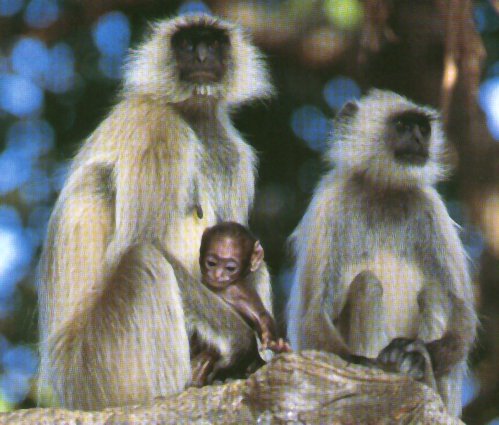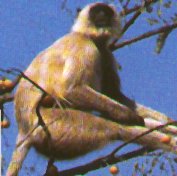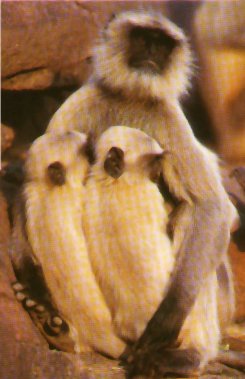
Hanuman Langur

Order: Primates Family: Cercopithecidae Genus & Species: Semnopithecus entellus
Found throughout the Indian subcontinent and Sri Lanka, and north into the Himalayas of Pakistan, Bhutan, Burma (myanmar) and Bangladesh. They are very widespread but threatened everwhere by habitat loss. They are listed as endangered by the World Conservation Union.
 |
Habitat The hanuman langur has the widest range of any primate other than humans. It lives in desert fringes, savannah, woodland, tropical rainforest, and among alpine scrub and snow-covered pines in the Himalayas up to an altitude of 4,000m. Unusually for a primate, the Hanuman langur also thrives in cities. It is fed outside temples, steals food and raids crops, yet it is indulged because of its sacred status among Hindus and Buddhists. |
Behaviour Most troops comprise of 20-40 individuals: a single breeding male, several females and their offspring. Other troops are all male. Mixed troops occupy a home range of up to 13 sq km, while batchelor groups require 22 sq km. The langur spends 80 per cent of its time on the ground, but takes to the trees at any sign of danger. In the branches it moves with agility and speed, making enormous leaps of up to 13m between trees. |
 |
| The langur adjusts easily to human presence. It follows itinerant
holy men, who are given food that they then share with the monkey. Hindus put out
food for the langur, while shopkeepers even tolerate it when it steals titbits from their
stalls. |
 |
Feeding A troop of Hanuman langurs feeds in the morning and late afternoon, and snacks throughout the day. Each member sits alone in a tree, usually within 5m, of the ground, and faces outwards to keep watch for predators. Herds of axis deer gather under trees to feed on the foliage dropped by a troop. The association is beneficial to both species, the deer eat well, and the monkey gains protection because the deer are good at scenting out concealed predators such as leopards, tigers or dholes (Indian wilddogs). |
| The Hanuman langur has a wide-ranging diet and eats food that other
animals would find unpalatable or even poisonous. It feeds on the fruit of
Strychnos nux-vomica, which contains enough strychnine to kill the rhesus
macaque. It can also eat repulsive and evil smelling, latex-bearing plants.
Its complex, folded stomach harbours helpful bacteria that neutralize any toxins before
the food passes into the lower stomach. |
Breeding Mating occurs throughout the year, but in areas that experience seasonal rains, most births occur in the dry season. The female initiatates mating by looking at the male. If he ignores her, she may hit him, pull his fur or even bite him. Seven months after mating, the female gives birth to a single offspring. Within a few hours, the newborn is passed around other females in the troop, some of whom may even suckle the infant. The youngster gains its colouration at five to ten months, and is weaned at 13-20 months. Young females stay within the natal troop. Young males leave at three to five years, usually when their natal troop is taken over by a new adult male. They join a batchelor troop, often together with the ousted male, who in all likelyhood is their true father. |
 |